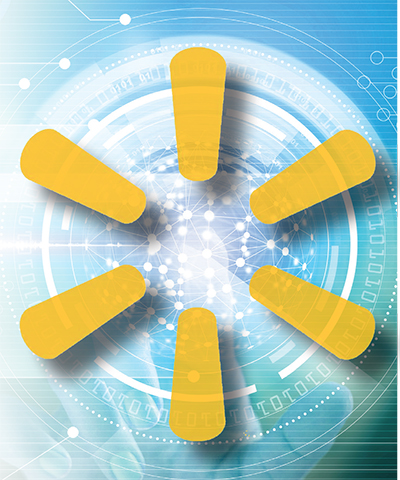Sorry, but your login has failed. Please recheck your login information and resubmit. If your subscription has expired, renew here.
September-October 2017
When it comes to the next generation of supply chain management, the future just may be now. That’s one of the conclusions reached by Greg Gorbach, an analyst at the research firm ARC Advisory Group, after surveying supply chain executives, including subscribers to Supply Chain Management Review, on the digitization of their supply chains. In “The Great Digitization of Industry,” Gorbach notes that while it may take years for the widespread adoption of new technologies such as machine learning, additive manufacturing, smart factories and advanced analytics to become commonplace, digitization across verticals is happening faster than many of us… Browse this issue archive.Need Help? Contact customer service 847-559-7581 More options
“We’ll be the first to deliver a seamless shopping experience at scale: No matter how you choose to shop at Wal-Mart—in stores, online, mobile or a combination—it will be fast and easy.” –Wal-Mart 3-Year Growth Plan
Retail has always been competitive. But, with the rise of pure-play e-commerce giants like Amazon, an over-abundance of retail stores and an ever-changing consumer, it’s hard to imagine a tougher environment for brick-and-mortar retailers.
Jumping into e-commerce is no longer an option for any major retailer that wants to survive. As a result, many are hatching plans to integrate the different distribution channels of their businesses in order to compete in the new retail landscape, what we’ve come to think of as omni-channel distribution. We think there’s a better way. Rather than integration, which can take time to accomplish, the goal should be to create a seamless synergy between the different functions of the organization—perhaps we can call it “synergization.”
Our aim in the following pages is to establish that the perfect execution of the omni-channel customer experience is better implemented through omni-channel synergy than omni-channel integration, which has certain drawbacks. In fact, being “overly integrated” could result in rigidity and tardiness in responding to a fast-changing retail environment that is driven by changing consumption patterns and new technologies such as the Internet of Things and Artificial Intelligence.

This complete article is available to subscribers only.
Log in now for full access or start your PLUS+ subscription for instant access.
SC
MR
Sorry, but your login has failed. Please recheck your login information and resubmit. If your subscription has expired, renew here.
September-October 2017
When it comes to the next generation of supply chain management, the future just may be now. That’s one of the conclusions reached by Greg Gorbach, an analyst at the research firm ARC Advisory Group, after surveying… Browse this issue archive. Access your online digital edition. Download a PDF file of the September-October 2017 issue.“We'll be the first to deliver a seamless shopping experience at scale: No matter how you choose to shop at Wal-Mart—in stores, online, mobile or a combination—it will be fast and easy.” –Wal-Mart 3-Year Growth Plan
Retail has always been competitive. But, with the rise of pure-play e-commerce giants like Amazon, an over-abundance of retail stores and an ever-changing consumer, it's hard to imagine a tougher environment for brick-and-mortar retailers.
Jumping into e-commerce is no longer an option for any major retailer that wants to survive. As a result, many are hatching plans to integrate the different distribution channels of their businesses in order to compete in the new retail landscape, what we've come to think of as omni-channel distribution. We think there's a better way. Rather than integration, which can take time to accomplish, the goal should be to create a seamless synergy between the different functions of the organization—perhaps we can call it “synergization.”
Our aim in the following pages is to establish that the perfect execution of the omni-channel customer experience is better implemented through omni-channel synergy than omni-channel integration, which has certain drawbacks. In fact, being “overly integrated” could result in rigidity and tardiness in responding to a fast-changing retail environment that is driven by changing consumption patterns and new technologies such as the Internet of Things and Artificial Intelligence.
SC
MR


Latest Supply Chain News
- Retail sales see gains in October, reports Commerce and NRF
- Balancing green and speed: Home delivery insights from the pandemic era
- AdventHealth named top healthcare supply chain by Gartner
- Geopolitical readiness in supply chains: Strategic challenges for leaders
- Unlocking retention: The role employee engagement plays
- More News
Latest Podcast

 Explore
Explore
Procurement & Sourcing News
- Retail sales see gains in October, reports Commerce and NRF
- Geopolitical readiness in supply chains: Strategic challenges for leaders
- With capacity to spare, logistics real estate demand remains subdued
- Tariffs, taxes and trade: The impact of Trump’s reelection on the supply chain
- How to improve demand forecasts for new product families
- Aggregators sitting on the throne of Africa’s e-commerce supply chains: What lessons can we learn?
- More Procurement & Sourcing
Latest Procurement & Sourcing Resources

Subscribe

Supply Chain Management Review delivers the best industry content.

Editors’ Picks





